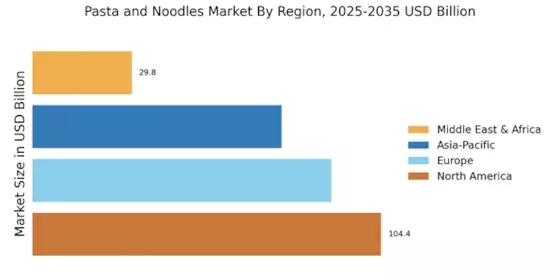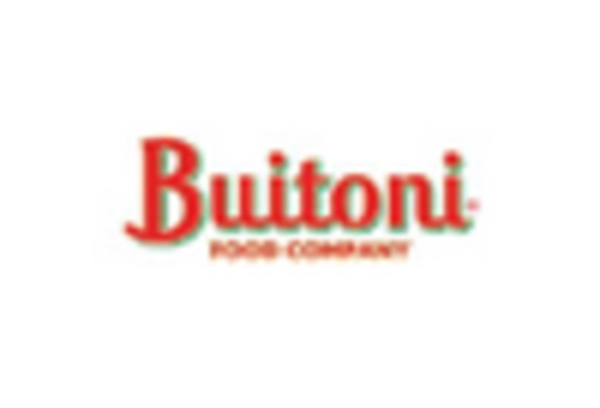Health and Wellness Trends
The Pasta and Noodles Market Industry is significantly influenced by the growing health and wellness trends among consumers. There is an increasing awareness of the nutritional content of food, leading to a demand for healthier pasta and noodle options. Whole grain, gluten-free, and low-carb varieties are becoming more prevalent as consumers seek alternatives that align with their dietary preferences. Market data indicates that the health-focused segment of the pasta and noodles market is expanding, with sales of whole grain and gluten-free products showing substantial growth. This shift towards healthier options is prompting manufacturers to reformulate existing products and introduce new lines that cater to health-conscious consumers, thereby enhancing their competitive edge in the market.
Convenience and On-the-Go Consumption
The Pasta and Noodles Market Industry is adapting to the fast-paced lifestyle of modern consumers, leading to a surge in demand for convenient and ready-to-eat products. With an increasing number of individuals seeking quick meal solutions, manufacturers are focusing on developing instant noodles and pre-packaged pasta meals that require minimal preparation. Market data suggests that the convenience food sector is expanding, with ready-to-eat pasta and noodles gaining traction among busy professionals and families. This trend is further fueled by the rise of online grocery shopping, making it easier for consumers to access these products. As a result, brands are innovating packaging and product formats to enhance convenience, thereby capturing a larger share of the market.
Growing Popularity of Ethnic Cuisines
The Pasta and Noodles Market Industry is witnessing an increasing interest in ethnic cuisines, which is driving the demand for various pasta and noodle types. As consumers become more adventurous in their culinary choices, they are exploring traditional dishes from different cultures, such as Asian noodles and Italian pasta. This trend is reflected in market data showing a rise in sales of specialty noodles and pasta that cater to diverse culinary preferences. The incorporation of unique flavors and ingredients from various cuisines not only enhances the dining experience but also encourages consumers to experiment with cooking at home. This growing popularity of ethnic cuisines presents opportunities for brands to diversify their product offerings and tap into new consumer segments.
Rising Demand for Plant-Based Products
The Pasta and Noodles Market Industry is experiencing a notable shift towards plant-based offerings. As consumers increasingly prioritize health and sustainability, the demand for pasta and noodles made from alternative ingredients, such as lentils, chickpeas, and quinoa, is on the rise. This trend is supported by data indicating that the plant-based food market is projected to grow significantly, with pasta and noodles being a key segment. The appeal of these products lies in their nutritional benefits, including higher protein and fiber content, which align with the health-conscious consumer's preferences. Consequently, manufacturers are innovating to create diverse plant-based pasta options, thereby expanding their market reach and catering to a broader audience.
Sustainability and Eco-Friendly Practices
The Pasta and Noodles Market Industry is increasingly embracing sustainability as a core principle, driven by consumer demand for eco-friendly products. As environmental concerns rise, brands are adopting sustainable sourcing practices and eco-friendly packaging solutions. This trend is reflected in market data indicating that consumers are willing to pay a premium for products that are environmentally responsible. Manufacturers are exploring innovative ways to reduce their carbon footprint, such as utilizing renewable energy in production and minimizing waste. The emphasis on sustainability not only appeals to environmentally conscious consumers but also positions brands favorably in a competitive market. As the industry evolves, the integration of sustainable practices is likely to become a key differentiator for success.


















Leave a Comment